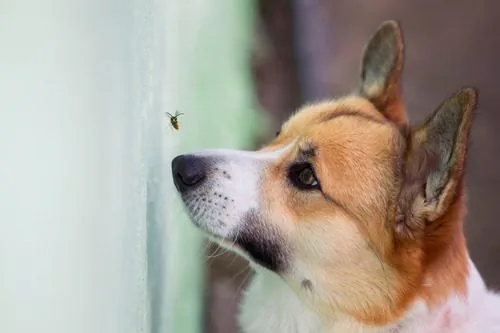Dog Stung by Bee: Handling Canine Bee Stings Safely
When your dog is stung by a bee, it can be a distressing experience for both you and your furry companion. Understanding how to handle canine bee stings safely is crucial to ensuring your dog’s health and comfort. This guide will walk you through what happens when a dog is stung by a bee, how to recognize the symptoms, and what steps to take to address the situation effectively.

Recognizing the Symptoms of a Bee Sting in Dogs
Dogs, much like humans, can have varied reactions to bee stings. Recognizing the symptoms early on can help you manage the situation more effectively.
Common Symptoms of Bee Stings in Dogs
When a dog is stung by a bee, the most immediate reaction is often localized pain and swelling. You may notice your dog licking or biting the affected area. Common symptoms include:
- Swelling at the sting site
- Redness and inflammation
- Excessive licking or scratching
- Whimpering or signs of discomfort
- Visible sting or stinger in the skin
Severe Reactions to Bee Stings
In some cases, dogs may have an allergic reaction to bee stings, which can be more serious. Symptoms of a severe reaction include:
- Difficulty breathing
- Swelling around the mouth, throat, or eyes
- Vomiting or diarrhea
- Weakness or collapse
If you observe any of these severe symptoms, seek immediate veterinary care by calling St. Paul Pet Hospital at (651) 789-6275.
Immediate Actions to Take When Your Dog Is Stung by a Bee
Knowing the immediate steps to take can help alleviate your dog’s pain and prevent further complications.
Removing the Stinger
The first step when your dog is stung by a bee is to remove the stinger. This is crucial because the longer the stinger remains embedded, the more venom it releases. Use a flat object, like a credit card, to scrape the stinger out. Avoid using tweezers, as squeezing the stinger can inject more venom into the wound.
Cleaning the Sting Area
After removing the stinger, clean the affected area with mild soap and water. This helps to reduce the risk of infection and soothe the irritated skin. Pat the area dry gently with a clean towel.
Managing Pain and Swelling
Once the stinger is removed and the area is cleaned, the next step is to manage your dog’s pain and swelling.
- Applying a Cold Compress: A cold compress can help reduce swelling and numb the pain. Wrap ice in a cloth or use a cold pack and apply it to the sting site for about 10 minutes. This can be repeated several times a day as needed.
- Monitoring for Allergic Reactions: Keep a close eye on your dog for any signs of an allergic reaction. Even if the initial reaction seems mild, symptoms can worsen over time. Monitoring your dog’s behavior and physical condition is crucial during the first 24 hours after the sting.
Long-Term Care and Prevention
Taking steps to prevent future bee stings and understanding long-term care is important for your dog’s overall well-being.
Preventing Future Bee Stings
Preventing bee stings can be challenging, but there are measures you can take to reduce the risk. Keep your dog away from areas with high bee activity, such as flower beds and gardens. During walks, steer clear of places where bees are likely to be present. Additionally, avoid using scented sprays or lotions on your dog that might attract bees.
Knowing When to Visit the Vet
While mild bee stings can often be managed at home, there are times when a visit to the vet is necessary. If your dog shows signs of a severe allergic reaction, or if the swelling and discomfort persist for more than a day, contact St. Paul Pet Hospital at (651) 789-6275 for professional advice and care.
Understanding Bee Allergies in Dogs
Some dogs can develop allergies to bee stings, which can make future stings more dangerous. If your dog has had a severe reaction to a bee sting in the past, it’s important to discuss this with your veterinarian.
Emergency Preparedness
For dogs with known bee allergies, your vet may recommend carrying an epinephrine auto-injector and provide instructions on its use. This can be a lifesaver in the event of a severe allergic reaction.
Keeping Your Dog Safe and Comfortable After a Bee Sting
Understanding how to handle a situation where your dog is stung by a bee is essential for any pet owner. By recognizing the symptoms, taking immediate action, managing pain and swelling, and knowing when to seek veterinary care, you can ensure your dog’s safety and well-being. For any concerns or if your dog shows severe symptoms, contact St. Paul Pet Hospital at (651) 789-6275. Your dog’s health and comfort are our priority.

